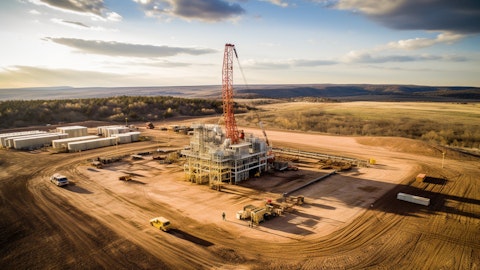Ati Modak: Got it. Thank you for taking the questions. I will turn it over.
Chris Stavros: Okay, thanks.
Operator: The next question comes from Nicholas Pope of Seaport Research. Please go ahead.
Nicholas Pope: Good morning, everyone.
Chris Stavros: Hi, Nick.
Nicholas Pope: A quick question on the reserves details that you provided in the presentation. The price-related revisions, just wanted to make sure, is that — is there anything specific there, or is that kind of balanced across the two assets? Is it just the tail of some of those PDP reserves coming off? Just trying to make sure, I understand that $15 million kind of hit the [indiscernible] there.
Brian Corales: Yeah. And when you roll forward from last year, which had significantly higher pricing, you do lose reserves. So the year-over-year change in the SEC required pricing was relatively significant both oil and gas.
Nicholas Pope: So it’s across both assets.
Brian Corales: It’s both assets. It’s both assets. But I mean, just remember, I think we’re at 75% plus of our, or 75% of our production is Giddings. So it’s probably proportionate.
Nicholas Pope: And on the Giddings acquisition, can you be a little more specific, about what was the timing of the close of that acquisition?
Chris Stavros: It was right around mid-November.
Nicholas Pope: Yeah. Okay. That’s all I had. Thanks.
Chris Stavros: Okay. Thanks.
Operator: The next question comes from Geoff Jay of Daniel Energy Partners. Please go ahead.
Geoff Jay: Hey, guys. I was just kind of curious, you talk about the efficiency gains, particularly on the completion side. Can you help understand — help me understand, I guess like, how significant that increase is? And if you’ve sort of looked around and benchmarked that against your peers, and if you think there’s further efficiencies to come this year?
Chris Stavros: We’re looking into that now. I mean we are going through that process right now as we look to the latter portion, or trying to think ahead into the back half of the year on our equipment and cruise, I don’t know how much I can really add on that specific item for you, Jay — Geoff, I just don’t know.
Brian Corales: And Geoff, if — I’ll just maybe add one thing, and Chris talked about a little bit, is we did a really, really good job on stages per day on the completion side. One of the focus is on — more for this year is on the drilling side to improve more of those efficiencies.
Geoff Jay: Right. Got it. I guess when I saw in the press release that the cost of Giddings, well costs were down about 20%. And my curiosity was piqued about sort of how that might sort of break down between efficiency gains and sort of pricing. And I don’t know if you can — if there was a way to you can kind of help me understand the interplay there.
Chris Stavros: Well, a lot of it was, as you know, a lot of it was steel OCTG, but there was — there were meaningful steps in stem and frac. So there are meaningful benefits there as well.
Geoff Jay: Excellent. Thank you.
Operator: The next question comes from Zach Parham of JPMorgan. Please go ahead.
Zach Parham: Yes, thanks for taking my question. I guess first just could you quantify where your leading edge D&C costs are in Giddings? And maybe give us some color on how much cheaper you expect the wells to be on the newly acquired shallower acreage?
Chris Stavros: Yeah, the wells now are running about 1,100 a foot I would say. And that’s about 20% lower than a year ago. And so that — for the longer — some of the longer laterals that we’ll drill this year, that’s maybe $9 million roughly per well. The well costs for the newer stuff, yeah as I said, they’re shallower, quite a bit shallower, 3000, 4000 feet shallower. But you don’t get the exact efficiencies of pad development too. So, that’s sort of what I know right now.
Brian Corales: And Zach let’s — we need to drill one first before we can give you a better answer. But it is shallower, so on a per foot, it should be a little cheaper.
Zach Parham: Got it. Thanks for that color, I guess also wanted to ask on natural gas. Gas differentials have widened out a bit versus both Henry hub and Ship Channel over the last couple of quarters. We’ve also heard some concerns on Ship Channel widening out further given increasing Permian volumes flow into the Gulf. Can you just give us your thoughts on how you expect gas differentials to trend in ’24 and going forward?
Chris Stavros: Yeah. To be honest, I mean, all our gas goes to Ship Channel. We are a price taker. I still think it’s the second probably best hub outside of Henry Hub to deliver your gas. We’re closer to market than the Permian. We have all the infrastructure we need. Is gas in general challenged? Yes.
Brian Corales: Zach, it’s going to be interesting to really see how this evolves in the market. You’ve probably seen already some of the comments from some of the independent producers, the gassier producers here, maybe reducing their activity a bit. And so this is a market and the operators will respond to the economics. So it will be interesting to see that response and to the extent that things are pulled in, that may over time bring things into better balance. So we’ll see.





